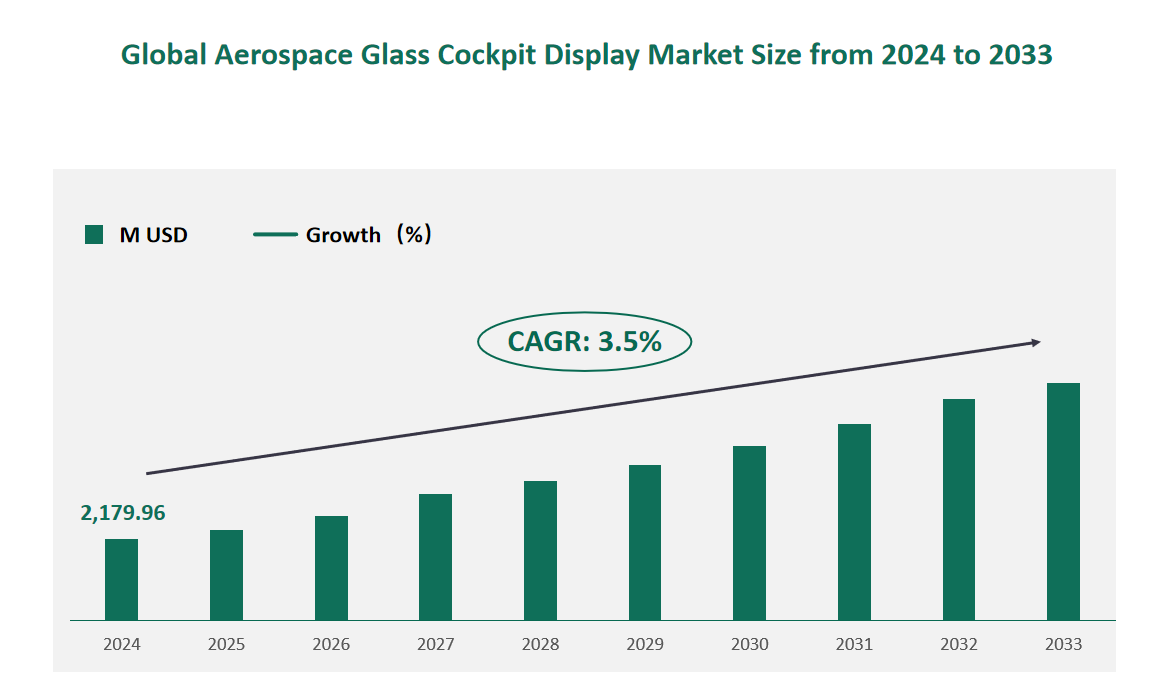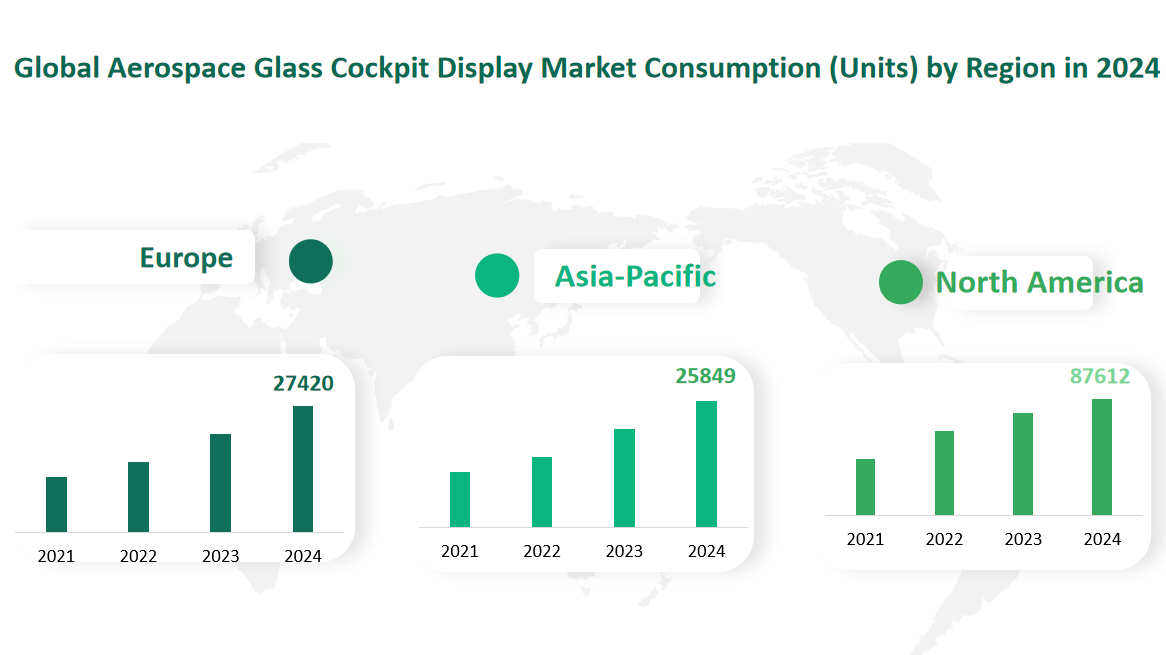1 Global Aerospace Glass Cockpit Display Market Size (Value) and CAGR (2024-2033)
In 2024, the global Aerospace Glass Cockpit Display market was valued at USD 2,179.96 million, with a CAGR of 3.5% from 2024 to 2033.
Aviation glass cockpit displays are also called cockpit displays, head-down displays (HDD) or electronic flight instrument system (EFIS) displays, usually a collection of several display screens, which constitute the display panel in the cockpit. Aerospace Glass Cockpit Display is an aircraft cockpit that features electronic (digital) flight instrument displays, typically large LCD screens, rather than the traditional style of analog dials and gauges. While a traditional cockpit relies on numerous mechanical gauges (nicknamed “steam gauges”) to display information, a glass cockpit uses several multi-function displays driven by flight management systems, that can be adjusted to display flight information as needed.
Figure Global Aerospace Glass Cockpit Display Market Size (M USD) and CAGR 2024-2033

2 Aerospace Glass Cockpit Display Market PESTEL Analysis
Political Factors
The political landscape significantly impacts the Aerospace Glass Cockpit Display market, primarily due to its applications in military and defense sectors. Governments play a crucial role in regulating the industry, with stringent export and import controls, especially for countries involved in international conflicts or subject to sanctions. For example, the United States imposes strict regulations on the export of advanced avionics to certain regions, directly affecting market accessibility.
Economic Factors
Economic conditions have a profound impact on the Aerospace Glass Cockpit Display market. The industry is capital-intensive, requiring significant investment in research and development, manufacturing, and regulatory compliance.
Social Factors
Societal trends also influence the market’s development. The increasing preference for high-tech products extends to the aviation industry, with pilots and operators demanding advanced, user-friendly displays that enhance situational awareness and operational efficiency. The growing awareness of flight safety and the need for real-time data have led to the widespread adoption of digital avionics.
Technological Factors
Technology is the cornerstone of the Aerospace Glass Cockpit Display market. Advances in digital avionics, such as high-resolution LCD screens, touchscreens, synthetic vision systems, and voice recognition technologies, have transformed the industry. These innovations not only improve flight safety and efficiency but also reduce pilot workload. The integration of advanced sensors and data management systems further enhances the functionality of glass cockpit displays.
Environmental Factors
Environmental considerations are increasingly important in the aerospace industry. The demand for fuel-efficient and environmentally friendly aircraft has led to the development of lightweight materials and advanced avionics, including glass cockpit displays. These displays contribute to reduced fuel consumption by optimizing flight operations and reducing aircraft weight.
Legal Factors
Legal and regulatory frameworks significantly impact the Aerospace Glass Cockpit Display market. Stringent safety regulations imposed by aviation authorities, such as the Federal Aviation Administration (FAA) in the United States and the European Union Aviation Safety Agency (EASA), require manufacturers to adhere to high standards of quality and reliability. Intellectual property laws protect the innovations of market players, encouraging R&D investment.
3 Global Aerospace Glass Cockpit Display Market Size and Share by Type in 2024
In 2024, the Primary Flight Display segment is expected to hold the largest market value, driven by its essential role in providing critical flight information. PFDs are a fundamental component of modern avionics systems, replacing traditional “steam gauges” with digital, high-resolution screens that offer superior accuracy and reliability. The market value of PFDs is projected to reach 903.41 million USD, reflecting their widespread adoption across various aircraft types.
The Multi-function Display segment is the second-largest, with a market value of 986.94 million USD. MFDs are highly versatile and customizable, making them an indispensable tool for pilots. They integrate navigation, communication, and engine monitoring functions into a single display, reducing cockpit clutter and enhancing situational awareness. The growth of this segment is driven by the increasing demand for advanced avionics in both commercial and military aviation.
The Mission Display segment, valued at 134.91 million USD, is primarily driven by military applications. These displays are designed to support complex missions by providing real-time tactical information and situational awareness. The growth of this segment is closely tied to the modernization efforts of military forces worldwide, particularly in regions experiencing geopolitical tensions.
Table Global Aerospace Glass Cockpit Display Market Size and Share by Type in 2024
Type | Market Size (M USD) 2024 | Market Share 2024 |
Primary Flight Display | 903.41 | 41.44% |
Multi-function Display | 986.94 | 45.27% |
Mission Display | 134.91 | 6.19% |
Others | 154.70 | 7.10% |
5 Global Aerospace Glass Cockpit Display Market Consumption (Units) by Application in 2024
Transport Aircraft are expected to consume 2,778 units in 2024. These aircraft, primarily used for cargo transportation, require robust and reliable avionics systems to ensure efficient operations. Glass Cockpit Displays enhance situational awareness and operational efficiency, making them a preferred choice for modern transport aircraft.
Fighters represent a significant portion of the market, with an estimated consumption of 41,443 units in 2024. Military fighter jets rely heavily on advanced avionics for mission-critical operations. Glass Cockpit Displays provide real-time tactical information, situational awareness, and enhanced pilot performance, making them essential for modern air forces. The increasing demand for advanced avionics in military applications drives the growth of this segment.
Helicopters are projected to consume 33,275 units in 2024. Both civil and military helicopters benefit from the enhanced safety and operational efficiency provided by Glass Cockpit Displays. These displays integrate navigation, communication, and situational awareness tools, making them indispensable for helicopter operations in various environments, including search and rescue, medical evacuation, and military missions.
Airliners are another critical segment, with an estimated consumption of 22,765 units in 2024. Commercial airliners increasingly adopt Glass Cockpit Displays to enhance flight safety, reduce pilot workload, and improve overall operational efficiency. The integration of advanced avionics systems in new aircraft models and the retrofitting of older fleets drive the demand for these displays in the airliner segment.
Table Global Aerospace Glass Cockpit Display Market Consumption (Units) by Application in 2024
Application | Market Consumption (Units) 2024 | Market Share 2024 |
Transport Aircraft | 2778 | 1.74% |
Fighter | 41443 | 25.89% |
Helicopter | 33275 | 20.79% |
Airliner | 22765 | 14.22% |
Others | 59813 | 37.37% |
6 Global Aerospace Glass Cockpit Display Market Consumption (Units) by Region in 2024
North America is expected to lead in consumption, with 87612 units in 2024. The region’s dominance is driven by its advanced aerospace industry, stringent safety regulations, and high demand for modern avionics in both commercial and military applications. The United States, in particular, is a major hub for aerospace manufacturing and innovation, contributing significantly to the region’s market share.
Europe is projected to consume 27420 units in 2024. The region’s aerospace industry is characterized by strong regulatory frameworks and a focus on advanced technologies. European countries, such as France, Germany, and the United Kingdom, are key players in the development and deployment of modern avionics systems. The demand for Glass Cockpit Displays in Europe is driven by the need for enhanced safety and operational efficiency in both civil and military aviation.
Asia-Pacific is the fastest-growing region, with an estimated consumption of 25849 units in 2024. The region’s rapid economic growth, increasing urbanization, and expanding aviation industry drive the demand for advanced avionics. China and India are emerging as significant markets, with substantial investments in commercial and military aviation. The modernization of aircraft fleets and the increasing adoption of digital avionics in the region contribute to its rapid growth.
Figure Global Aerospace Glass Cockpit Display Market Consumption (Units) by Region in 2024

7 Major Players in Global Aerospace Glass Cockpit Display Market
7.1 Honeywell Aerospace
Company Profile:
Honeywell Aerospace is a leading manufacturer of aircraft engines, avionics, and auxiliary power units (APUs) with a strong presence in both commercial and defense sectors. Established in 1936, the company is headquartered in the United States and operates primarily in North America, Europe, and Asia. Honeywell’s aerospace division is responsible for about 30% of the company’s total revenue, with significant contributions from both commercial and defense contracts.
Business Overview:
Honeywell Aerospace specializes in developing advanced avionics systems, including glass cockpit displays, flight control computers, and integrated electronic systems. The company’s products are widely used in commercial aircraft, military jets, and business aviation. Honeywell is known for its innovative solutions that enhance flight safety, efficiency, and pilot situational awareness.
Product Profiles:
Honeywell offers a range of aerospace glass cockpit displays, such as the 737 Display Electronics Unit and the DU-1310 Cockpit Display Unit. These products provide high-resolution primary and multi-function displays, enhancing pilot interaction and situational awareness. The DU-1310, for example, is designed for business aviation and offers advanced features like weather radar integration and terrain mapping.
Recent Financial Performance:
In the most recent year, Honeywell Aerospace reported a revenue of 261.07 million USD from its glass cockpit display products.
7.2 Rockwell Collins (Collins Aerospace)
Company Profile:
Rockwell Collins, now part of Collins Aerospace under Raytheon Technologies, is a multinational corporation specializing in avionics and information technology systems. Established in 2001, the company is headquartered in Cedar Rapids, Iowa, and has a global presence with operations in North America, Europe, and Asia. Rockwell Collins is known for its advanced avionics solutions used in both commercial and military aircraft.
Business Overview:
Rockwell Collins provides a wide range of avionics systems, including flight displays, communication systems, and navigation equipment. The company’s products are designed to enhance flight safety, efficiency, and pilot situational awareness. Rockwell Collins is particularly noted for its innovative glass cockpit displays, which have become standard in many modern aircraft.
Product Profiles:
Rockwell Collins’ flagship product, the AFD-2100 Adaptive Flight Display, is a high-resolution LCD display used in various aircraft models, including the Boeing 737 MAX and 787. The AFD-2100 offers advanced features such as split-screen capability, real-time weather updates, and synthetic vision systems. These displays are designed to improve pilot decision-making and operational efficiency.
Recent Financial Performance:
In the most recent year, Rockwell Collins reported a revenue of 195.87 million USD from its glass cockpit display products.
7.3 Thales SA
Company Profile:
Thales SA is a French multinational company specializing in electrical systems and avionics for the aerospace, defense, transportation, and security sectors. Established in 2000, Thales has a strong presence in Europe and operates globally, with significant sales in North America, Asia, and the Middle East. The company is known for its advanced avionics solutions, which are widely used in both civil and military aircraft.
Business Overview:
Thales provides a comprehensive range of avionics systems, including flight displays, navigation computers, and satellite communication systems. The company’s products are designed to enhance flight safety, efficiency, and pilot situational awareness. Thales is particularly noted for its innovative glass cockpit displays, which have become standard in many modern aircraft.
Product Profiles:
Thales’ FlytX is a next-generation tactile flight deck system designed for helicopters and airplanes. The FlytX system integrates large displays with advanced interaction capabilities, providing pilots with real-time information and enhanced situational awareness. This system is designed to be adaptable to various aircraft types and operational requirements.
Recent Financial Performance:
In the most recent year, Thales SA reported a revenue of 173.36 million USD from its glass cockpit display products.

